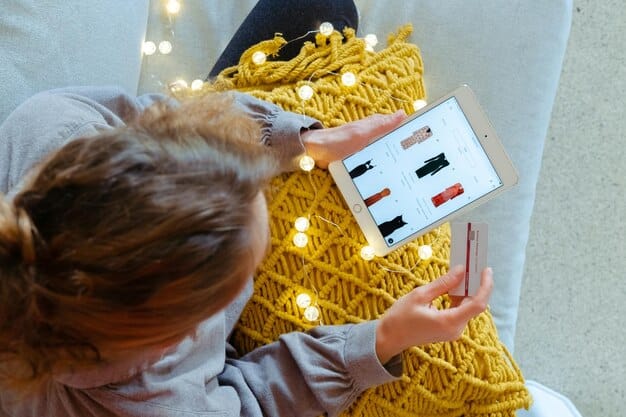Augmented Reality Shopping: Gen Z’s Impact on US Retail

Augmented Reality (AR) shopping is transforming the retail landscape in the US, with Gen Z leading the charge by adopting and driving the integration of AR technologies into their shopping experiences.
Augmented Reality (AR) shopping: How Gen Z is Redefining Retail Experiences in the US is not just a trend; it’s a revolution. Discover how this tech-savvy generation is reshaping how we shop, interact with brands, and experience retail in the digital age.
How augmented reality is changing the shopping experience
Augmented reality is no longer a futuristic concept; it’s a present-day reality transforming the shopping experience for consumers, especially Gen Z. AR enhances the shopping journey by overlaying digital content onto the real world, offering interactive and engaging experiences.
Enhanced Product Visualization
AR allows shoppers to visualize products in their own environment before making a purchase. This capability is particularly popular among Gen Z, who value practicality and visual validation.
Virtual Try-Ons
Virtual try-ons are a game-changer, especially in the fashion and cosmetics industries. Gen Z appreciates the convenience and hygiene of virtually trying on clothes, accessories, and makeup.

- Improved Decision Making: AR helps Gen Z make more informed purchase decisions by providing a realistic preview of the product.
- Increased Engagement: The interactive nature of AR keeps Gen Z engaged and entertained, making the shopping experience more enjoyable.
- Reduced Returns: By allowing customers to virtually “try” products, AR reduces the likelihood of returns due to incorrect fit or dissatisfaction.
- Personalized Experiences: AR can offer personalized recommendations and customizations, catering to the individual preferences of Gen Z shoppers.
AR’s ability to bridge the gap between online and offline shopping has made it an invaluable tool for retailers looking to attract and retain Gen Z customers. Its immersive and interactive features align perfectly with Gen Z’s preferences, making shopping more convenient, engaging, and personalized.
Gen Z: The driving force behind AR shopping adoption
Gen Z, born between the late 1990s and early 2010s, is the first generation to grow up entirely in the digital age. Their familiarity with technology and their demand for seamless, engaging experiences make them the driving force behind AR shopping adoption.
Tech-Savvy and Digital Natives
Gen Z’s innate understanding of technology makes them quick to embrace new innovations like AR. They are comfortable using smartphones, apps, and other digital tools to enhance their shopping experiences.
Demand for Immersive Experiences
Unlike older generations, Gen Z seeks immersive and interactive experiences that go beyond traditional shopping. AR provides the sensory engagement and entertainment that Gen Z craves.
- Early Adopters: Gen Z is more likely to try new technologies and incorporate them into their daily lives, making them key adopters of AR shopping.
- Social Influence: Gen Z’s online presence and social media activity help spread awareness and adoption of AR shopping among their peers.
- Expectation of Convenience: Gen Z values convenience and efficiency, and AR shopping offers a seamless way to try products and make purchases from anywhere.
The adoption of AR shopping by Gen Z is not merely a trend; it is a reflection of their tech-savvy nature and their desire for immersive, convenient shopping experiences. Retailers that cater to these preferences are more likely to win over this influential demographic.
Examples of successful AR shopping experiences targeting Gen Z
Several brands have successfully integrated AR into their shopping experiences to attract and engage Gen Z shoppers. These examples demonstrate the potential of AR to enhance brand perception, drive sales, and create lasting customer relationships.
Sephora Virtual Artist
Sephora’s Virtual Artist app allows users to virtually try on makeup products using their smartphone cameras. This feature is particularly popular among Gen Z, who enjoy experimenting with different looks and sharing their creations on social media.
Warby Parker Virtual Try-On
Warby Parker’s virtual try-on feature enables customers to see how different eyewear styles look on their faces before making a purchase. This AR experience has been a hit with Gen Z, who appreciate the ability to personalize their shopping experience.

- IKEA Place: IKEA’s app allows customers to virtually place furniture in their homes using AR, helping them visualize how the products will fit and look in their spaces.
- Nike Fit: Nike’s app uses AR to measure users’ feet and recommend the perfect shoe size, ensuring a better fit and reducing returns.
- Gucci App: Gucci’s app features AR try-ons for shoes, allowing customers to see how different styles would look on their feet in real-time.
These successful examples demonstrate that AR shopping experiences are not just gimmicks; they are valuable tools that enhance the customer journey, build brand loyalty, and drive sales among Gen Z shoppers. By offering interactive, personalized, and convenient experiences, these brands have effectively tapped into the preferences of this influential demographic.
The benefits of AR shopping for retailers and consumers
AR shopping offers a wide range of benefits for both retailers and consumers. From enhancing engagement to driving sales, AR has the potential to revolutionize the shopping experience and create lasting value for all stakeholders.
Increased Engagement and Brand Loyalty
AR shopping creates more engaging and memorable experiences that foster brand loyalty among consumers, especially Gen Z. The interactive nature of AR keeps shoppers entertained and coming back for more.
Higher Conversion Rates and Sales
By providing a realistic preview of products and reducing uncertainty, AR shopping can lead to higher conversion rates and increased sales for retailers. Customers are more likely to make a purchase when they can visualize the product in their own environment.
- Reduced Returns: AR helps customers make more informed purchase decisions, reducing the likelihood of returns due to incorrect fit or dissatisfaction.
- Data Collection and Personalization: AR shopping provides retailers with valuable data about customer preferences and behavior, enabling them to personalize the shopping experience and offer targeted recommendations.
- Competitive Advantage: Retailers that embrace AR shopping can differentiate themselves from competitors and attract tech-savvy customers like Gen Z.
The benefits of AR shopping extend beyond immediate sales gains. By enhancing the customer experience, building brand loyalty, and providing valuable data, AR can help retailers create sustainable growth and maintain a competitive edge in the rapidly evolving retail landscape. For consumers, AR offers a more convenient, engaging, and personalized shopping experience that enhances their overall satisfaction.
Challenges and future trends in AR shopping
Despite its numerous benefits, AR shopping also faces certain challenges that need to be addressed for widespread adoption. As technology evolves and consumer expectations change, several future trends are likely to shape the AR shopping landscape.
Technological Limitations and Infrastructure
Current AR technology has limitations in terms of accuracy, processing power, and device compatibility. Overcoming these challenges will require ongoing innovation and infrastructure improvements.
Privacy and Data Security Concerns
AR shopping relies on collecting and processing user data, raising privacy and data security concerns. Retailers need to be transparent about their data practices and implement robust security measures to protect customer information.
- Improved AR Technology: Advances in AR technology will lead to more accurate, immersive, and seamless shopping experiences.
- Integration with AI and Machine Learning: AI and machine learning will enable AR apps to offer more personalized recommendations and predictive shopping experiences.
- Increased Accessibility: As AR technology becomes more accessible and affordable, it will be integrated into more devices and platforms, expanding its reach to a wider audience.
Addressing the challenges and embracing future trends will be crucial for unlocking the full potential of AR shopping. By investing in technology, building trust with consumers, and adapting to changing preferences, retailers can harness the power of AR to revolutionize the shopping experience and create lasting value.
How retailers can effectively integrate AR into their strategies
For retailers looking to effectively integrate AR into their strategies, it’s essential to focus on creating seamless, valuable, and engaging experiences that resonate with their target audience, particularly Gen Z. This involves careful planning, strategic partnerships, and a customer-centric approach.
Understanding the Target Audience
Before implementing AR, retailers must understand the needs, preferences, and behaviors of their target audience. This includes researching their tech habits, shopping behaviors, and expectations for AR experiences.
Choosing the Right AR Applications
Retailers should select AR applications that align with their brand identity, product offerings, and target audience. This might include virtual try-ons, product visualization, or interactive games.
| Key Aspect | Brief Description |
|---|---|
| 📱 Gen Z & AR | Gen Z leads the adoption of Augmented Reality (AR) in shopping, seeking immersive experiences. |
| 🛍️ AR Benefits | AR enhances visualization, engagement, and personalization in shopping. |
| ✅ Successful AR Examples | Brands like Sephora and Warby Parker use AR for virtual try-ons, improving customer satisfaction. |
| 🚀 Future of AR | AR’s future includes improved tech, AI integration, and increased accessibility for wider adoption. |
Frequently Asked Questions
▼
Augmented reality (AR) shopping enhances the retail experience by overlaying digital content onto the real world, enabling customers to visualize and interact with products in a more engaging way.
▼
Gen Z values convenience, personalization, and immersive experiences, all of which are offered by AR shopping. They are digital natives who appreciate the innovative and interactive nature of this technology.
▼
Examples include virtual try-ons for makeup and eyewear, product visualization in home environments, and AR experiences in mobile apps that allow customers to interact with products digitally.
▼
AR shopping increases customer engagement, provides personalized shopping experiences, improves conversion rates, and reduces returns by allowing customers to make more informed purchase decisions.
▼
Implementing AR in retail involves challenges such as technological limitations, privacy concerns, data security issues, and the need for retailers to continuously improve and adapt to customer expectations.
Conclusion
As Augmented Reality (AR) shopping: How Gen Z is Redefining Retail Experiences in the US continues to evolve, retailers who embrace innovation and prioritize consumer experience will be best positioned to thrive in the future of retail. Integrating AR into shopping strategies not only meets the demands of tech-savvy consumers but also opens new avenues for growth and customer engagement.


